There are more than 60 species of wild mammals resident in Scotland and, discounting those that live in the sea, the majority of them are found close to human habitation. A project led by South West Scotland Environmental Information Centre (SWSEIC) is seeking volunteers in the Galloway Glens area willing to host an infra-red camera or a bat detector to better understand our wild neighbours and their distribution.
Remote Highland Glens and wilderness areas are certainly important for wildlife, but there are more species of mammal in our towns, villages and gardens. Some wild mammals, especially bats, actually live in the same buildings as us. Red Foxes reach their greatest population density in towns and cities, and even the Otter, often thought of as a shy mammal, is at home in many urban watercourses. Yet we rarely see our mammal neighbours, mainly because they are active during the night, whilst we are asleep. Which wild mammals share your living spaces, possibly more than you think?!
If you live in the Ken/Dee Valley, between Carsphairn and Kirkcudbright Bay, and would like to find out about your wild neighbours, now is your opportunity. Contact SWSEIC’s Peter Norman on [email protected] to borrow an infra-red camera or a bat detector, together with expert assistance from South West Scotland Environmental Information Centre (SWSEIC). Both pieces of equipment can be set up in your garden or local greenspace and left unattended to monitor wild mammals whilst you sleep. The equipment will be automatically triggered to record when an animal is detected close-by, and the information collected will assist local and national conservation projects.
The project is funded through the Galloway Glens ‘Our Heritage’ Small Grants Scheme. The Scheme is overseen by Anna Harvey, Galloway Glens Administrator. Anna said:
“The ‘Wild Mammals at Home’ project is an opportunity for people to find out about any wild visitors to their Ken/Dee gardens or open spaces, while also improving our wildlife records by supplementing SWSEIC’s database of sightings. This is ‘citizen science’ in action! A big thank you to the National Lottery Heritage Fund for supporting this great project.”






